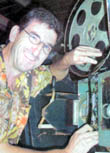|
|
 
|
|
Author
|
Topic: New Kodak VISION2 Films (EI 100, EI 200 speeds)
|
John Pytlak
Film God

Posts: 9987
From: Rochester, NY 14650-1922
Registered: Jan 2000
|
 posted 02-24-2004 08:17 AM
posted 02-24-2004 08:17 AM





Just announced today (February 24, 2004):
http://www.kodak.com/cgi-bin/US/en/corp/pressCenter/headlines.cgi
quote:
LOS ANGELES, Feb. 24 -- Eastman Kodak Company introduced today two new films within its VISION2 family of color negative film technology, reinforcing the company's commitment to making the world's finest films for the benefit of cinematographers and moviegoers.
Kodak the world's No. 1 maker of motion-picture film first brought VISION2 to market in November 2002, with the introduction of KODAK VISION2 500T film. Since that time, cinematographers have made VISION2 their film of choice on movie sets: VISION2 now accounts for about 70% of color negative film shot on Hollywood-produced motion pictures.
The extension of the VISION2 family reflects the company's determination to make continued investments in those film markets where demand remains strong and where film technology provides unique benefits. This strategy complements Kodak's effort to accelerate investments in digital technologies for the benefit of its customers.
The company is adding to the KODAK VISION2 product line 100- and 200-speed, ultra-fine grain color negative films with specialized imaging characteristics. The company expects to introduce additional VISION2 products later in 2004.
"Nobody loves film like Kodak," says Kodak Chairman and CEO Daniel Carp. "These exciting new products reinforce our strong commitment to film technology. Kodak is dedicated to developing a full range of products and services both digital and traditional to help bring the visions of filmmakers to the screen so that the viewing audience enjoys the richest experience that technology can provide."
The new generation of KODAK VISION2 films leverages a leap forward in photochemical science and technology.
"The new films provide extraordinary creative latitude for cinematographers, coupled with efficiencies designed to retain the integrity of the original images during postproduction," said Robert Mayson, general manager of image capture and vice president of Kodak's Entertainment Imaging Division. "Cinematographers who have tested the new films are finding they can probe deeper into both highlight and shadow areas and record nuances in details that are important to the stories they are telling."
Both new films offer significant advances in under- and over-exposure latitude; extremely fine grain and enhanced capacities for recording subtle details in highlights and shadows. They are available in 16 mm, 35 mm and 65 mm formats.
"Filmmaking is an interpretive form of artistic expression," Mayson said. "These developments are a response to customers who have been telling us they want more flexibility and more creative latitude. They also want the ability to retain the subtlest details recorded on the negative during both optical and digital postproduction with the goal of putting them on cinema and television screens."
The KODAK VISION2 family of films incorporates new sensitizing layers that provide important advantages during postproduction. Kodak designed the exposed negatives to retain the fidelity of the original images when they are converted to digital and optical formats for postproduction.
Dean Semler, ASC, (The Alamo, Bruce Almighty, XXX, We Were Soldiers, Dances With Wolves) is among the cinematographers who have tested the new VISION2 stocks.
"Just as we are entering the digital revolution, Kodak comes out of left field with a magnificent new film stock (KODAK VISION2 200T Color Negative Film 5217) that truly surpasses all others."
Kodak is still in the relatively early stages of bringing recent advancements in emulsion technology to the marketplace, Mayson said. He anticipates additional developments before the end of the year.
Kodak continues to "Raise the Bar" with ever-improving image quality, and continues to invest in FILM. ![[thumbsup]](graemlins/thumbsup.gif)
| IP: Logged
|
|
|
|
|
|
|
|
|
|
|
|
|
|
Hugh McCullough
Expert Film Handler

Posts: 147
From: Old Coulsdon, Surrey, UK
Registered: Jan 2003
|
 posted 11-05-2004 06:40 AM
posted 11-05-2004 06:40 AM





quote: Ian Joseph Parfrey
Now Orwo film, THERE'S a good stock.
Yes, it could be if handled properly.
Their B/W NP22 film was nearly as good as FP4 if care was given in processing. Developed correctly in ID11 at a dilution of 1/1, agitation for 10 secs every minute, it gave beautiful negatives, with a tight grain structure and sharpness, that printed easily on grade 2 or 3 Multigrade paper, but you had to make certain that the temperature did not exceed 70F otherwise the grain just exploded. Very good for certain types of subject. The film seemed to have a built in yellow filter as it reproduced white clouds in a blue sky better than any other B/W film that I used. Mind you, their colour film was not so good. I believe that they were using an old Agfacolor colour process.
Do ORWO still exist. I have not seen any of their film since 1990.
| IP: Logged
|
|
|
|
|
|
|
|
Christian Appelt
Jedi Master Film Handler
Posts: 505
From: Frankfurt, Germany
Registered: Dec 2001
|
 posted 11-10-2004 02:37 PM
posted 11-10-2004 02:37 PM




quote:
Now Orwo film, THERE'S a good stock. [puke]
ORWO does manufacture motion picture film. When the East German film factory folded after the Berlin wall came down, a small group of former ORWO technicians founded a new new company called FILMOTEC. They specialize in black&white only, and they produce fine quality indeed.
With the original ORWO plant, the problem was that basically they used 1940s machines and technology because the German Democratic Republic (GDR or DDR, see GOOD BYE LENIN) could not afford the latest equipment.
But their ORWO NP55 b&w negative was a great low speed camera negative, while the ASA400 stock called NP77 was always troublesome, always had nicks in the base and heavy grain.
New ORWO stocks are really beautiful, I have shot more than 20.000 meters of their UN54 (ASA 80) and N74. Both give a more classic 1960s b&w image, and while I praise Eastman in color, in b&w ORWO/Filmotec is my preferred choice.
They also make b&w duplicating, positive and sound recording film.
What was indeed inferior was the ORWO color POSITIVE film. That stock, which needed a special, non-ECP compatible color process, was widely used in Eastern Europe and gave ORWO a bad name. Their color negatives, although low speed, were OK, I recently saw high end telecines of 1960s Orwocolor, and they absolutely hold up to Western technology of that time.
Here is the ORWO/Filmotec web site in English:
ORWO/FILMOTEC motion picture film
| IP: Logged
|
|
|
|
All times are Central (GMT -6:00)
|
|
Powered by Infopop Corporation
UBB.classicTM
6.3.1.2
The Film-Tech Forums are designed for various members related to the cinema industry to express their opinions, viewpoints and testimonials on various products, services and events based upon speculation, personal knowledge and factual information through use, therefore all views represented here allow no liability upon the publishers of this web site and the owners of said views assume no liability for any ill will resulting from these postings. The posts made here are for educational as well as entertainment purposes and as such anyone viewing this portion of the website must accept these views as statements of the author of that opinion
and agrees to release the authors from any and all liability.
|

 Home
Home
 Products
Products
 Store
Store
 Forum
Forum
 Warehouse
Warehouse
 Contact Us
Contact Us




 Printer-friendly view of this topic
Printer-friendly view of this topic






![[thumbsup]](graemlins/thumbsup.gif)

![[Cool]](cool.gif)

![[Smile]](smile.gif)

![[puke]](graemlins/puke.gif)





